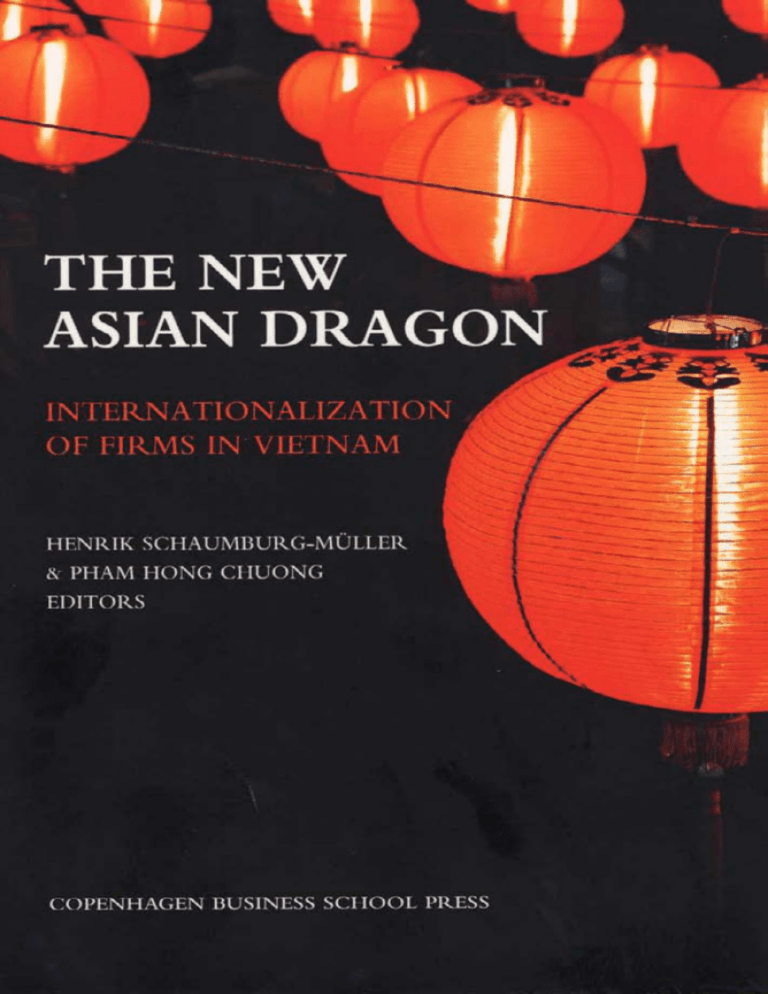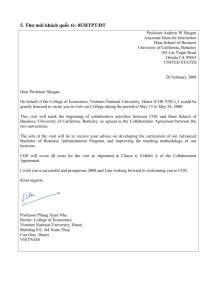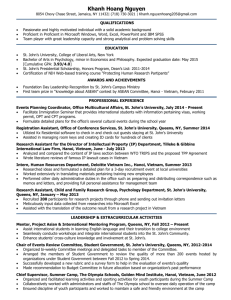
The New Asian Dragon
The New Asian Dragon
– Internationalization of Firms in Vietnam
Edited by
Henrik Schamumburg-Müller and Pham Hong Chuong
Copenhagen Business School Press
Henrik Schaumburg-Müller, Pham Hong Chuong, eds
The New Asian Dragon
Copenhagen Business School Press, 2010
Printed in Denmark by Narayana Press, Gylling
Typeset: SL grafik
Cover design by KlahrŇGraphic Design
1st e-book edition 2010
ISBN 978-87-630-9996-7
ISBN Printed Edition: 978-87-630-0228-8
All rights reserved. No part of this publication may be reproduced or used in any
form or by any means - graphic, electronic or mechanical including photocopying,
recording, taping or information storage or retrieval systems - without permission
in writing from Copenhagen Business School Press at www.cbspress.dk
Contents
List of Contributors · 7
Preface · 9
CHAPTER 1
The Dynamics of Firm Internationalization in Vietnam · 13
Henrik Schaumburg-Müller
CHAPTER 2
Trade Internationalization Paths of Emerging Market Firms:
Evidence from Vietnam · 39
Ha Thi Van Pham, Bent Petersen & Henrik Schaumburg-Müller
CHAPTER 3
An Explorative Study on Functional Upgrading and Export · 61
Pham Thi Song Hanh
CHAPTER 4
Conversion of Foreign Direct Investment Projects in Vietnam ·
89
Bui Huy Nhuong, Nguyen Thi Huong, Nguyen Anh Minh,
Ta Van Loi & Michael W. Hansen
CHAPTER 5
Culture and Performance of International Joint Ventures in
Vietnam · 115
Phan Thi Thuc Anh & Ngo Thi Minh Hang
CHAPTER 6
The Impact of Culture on Business Relationships · 135
Nguyen Hoang Anh & Nguyen Van Thoan
CHAPTER 7
Interaction between Expatriates and Local Vietnamese
Managers of MNCs in Vietnam: From a Learning
Perspective · 157
Dao Thi Thanh Lam & Olav Jull Sørensen
CHAPTER 8
Strategies of Vietnamese Firms in the Global Garment Value
Chain after the Multi-Fibre Arrangement · 183
Henrik Schaumburg-Müller, Pham Thu Huong & Dao Ngoc Tien
CHAPTER 9
Entrepreneurship and Strategic Options in a Development
Context: The Case of a Garment Producer in Vietnam · 203
Olav Jull Sørensen & Li Thuy Dao
CHAPTER 10
Strategic Options for Vietnamese Tea Processors in the Global
Value Chain · 227
Luong Thi Ngoc Oanh, Nguyen Thi Hai Yen & Olav Jull Sørensen
Index · 253
List of contributors
List of Contributors
Mr. Bui Huy Nhuong is PhD and lecturer at Trade and International Economics
Faculty, National Economics University, Hanoi, Vietnam.
Email: nhuongbh@neu.edu.vn
Mr. Dao Ngoc Tien is MBA and lecturer at Foreign Trade University, Hanoi,
Vietnam. Email: dntien_ftu@yahoo.com
Ms. Dao Thi Thanh Lam is PhD fellow at Department of Business Studies, Aalborg University and lecturer at Business School, National Economics University, Hanoi, Vietnam. Email: dttlam@bsneu.edu.vn
Ms. Ha Thi Van Pham is PhD fellow at Department of Intercultural Communication and Management at the Copenhagen Business School and lecturer at
Finance Banking Faculty, National Economics University, Hanoi, Vietnam.
Email: htvp.ikl@cbs.dk
Mr. Michael W. Hansen is PhD and associated professor at Centre for Business
and Development Studies, Department of Intercultural Communication and
Management at the Copenhagen Business School, Denmark.
Email: mwh.ikl@cbs.dk
Ms. Li Thuy Dao is a PhD fellow at Department of Business Studies at Aalborg
University, Denmark. Email: lidao@business.aau.dk
Ms. Luong Thi Ngoc Oanh is MA and lecturer at Foreign Trade University, Hanoi, Vietnam. Email: Ltnoanh@yahoo.com
Ms. Ngo Thi Minh Hang is MBA and lecturer at Business School, National Economics University, Hanoi, Vietnam. Email: nmhang@bsneu.edu.vn
Mr. Nguyen Anh Minh is PhD and lecturer at Trade and International Economics
Faculty, National Economics University, Hanoi, Vietnam.
Email: minhna@neu.edu.vn
Ms. Nguyen Hoang Anh is PhD and lecturer at Foreign Trade University, Hanoi,
Vietnam. Email: anh.nh.sdh@ftu.edu.vn
Ms. Nguyen Thi Hai Yen is MA and lecturer at Foreign Trade University, Hanoi,
Vietnam. Email: haiyen.nguyenthi@gmail.com
Ms. Nguyen Thi Huong is PhD and lecturer at Foreign Trade University, Hanoi,
Vietnam. Email: phamhuongvn@yahoo.com
Mr. Nguyen Van Thoan is MBA and lecturer at Foreign Trade University, Hanoi,
Vietnam. Email: thoannv@yahoo.com
Mr. Bent Petersen is PhD in international business and professor with special
responsibility at Centre for Strategic Management and Globalisation at the
Copenhagen Business School, Denmark. Email: bp.smg@cbs.dk
7
The New Asian Dragon
Mr. Pham Hong Chuong is PhD and associated professor at National Economics
University, Hanoi, Vietnam. Email: chuongph@neu.edu.vn
Ms. Pham Thi Song Hanh is PhD fellow at Department of Intercultural Communication and Management at the Copenhagen Business School and lecturer at
Foreign Trade University, Hanoi, Vietnam. Email: pshanh@yahoo.com
Ms. Pham Thu Huong is PhD in Economics and lecturer of Graduate School,
Foreign Trade University, Vietnam. Email: phamhuongvn@yahoo.com
Ms. Phan Thi Thuc Anh MBA and lecture at Business School of National Economics University, Hanoi, Vietnam. Email: ptanh@bsneu.edu.vn
Mr. Henrik Schaumburg-Müller is an economist and professor at the Centre for
Business and Development Studies, Department of Intercultural Communication and Management at the Copenhagen Business School, Denmark.
E-mail: hsm.ikl@cbs.dk
Mr. Olav Jull Sørensen is professor at Department of Business Studies at Aalborg University, Denmark. Email: ojs@business.aau.dk
Mr. Ta Van Loi is PhD and lecturer at Trade and International Economics Faculty,
National Economics University, Hanoi, Vietnam. Email: loitv@neu.edu.vn
8
Preface
Preface
Vietnam appears well-positioned to become a new East Asian dragon.
—George Irwin, Vietnam: Assessing the Achievements of Doi Moi1
By 1995, nearly a decade after the introduction of Vietnam’s economic Doi Moi
reform policies, the country had already made significant progress in following the footsteps of other economies in the region by becoming successfully
integrated into the global economy. The economy had been liberalized and was
becoming increasingly market driven. Even factoring in the Asian financial crisis
that hit the region in 1997, the Vietnamese economy was able to recover quickly,
achieving double-digit growth rates in income and exports after 2000 and continuously reducing poverty rates. Much is known about the policies that were
applied to help this transformation and build the institutions in which markets
and companies could operate. There have been however, far fewer studies that
tell us how the firms formed their internationalization strategies and gained international competitiveness. In Vietnam, the discipline of international business
has not been a main component in the business and management curricula at
universities and business schools, yet managers in domestic and foreign firms
have been competing and collaborating, based on their more or less deliberately
formulated business models and internationalization strategies.
In this sense, Vietnam has truly been an emerging market economy, and a
rather successful one. However, success also transforms the business community,
as well as the national economy. This transformation has occurred during a time
when the regional and global economies have also been changing. Consequently,
Vietnamese firms are now facing a new global environment of economic recession and financial turmoil. This book is a contribution to understanding the internationalization processes and strategies of firms in Vietnam. By assessing the
legacy and path during the reform era, important questions are addressed: How
robust is the business sector? How will it face these new global challenges? The
aim is to stimulate managerial debate and research regarding how Vietnamese
companies have become change agents in a region that has seen waves of latecomer firms transform economies into small dragons (Vogel 1991), if not into
dragon multinationals (Mathews 2002) driving former agrarian economies into
1 George Irwin (1995). ”Vietnam: Assessing the Achievements of Doi Moi “, The
Journal of Development Studies, 31:5, pp. 725-750.
9
The New Asian Dragon
newly industrialized market economies. The dragon is in the region the symbol
of power.
These changes might have been part of regional processes, described by
Akamatsu Kanabe as a Japanese-led “flying geese formation,” or driven by internationalizing processes stemming from the enormous buying power of the
global and in particularly the American markets. Although Vietnam’s path to
economic development may resemble the rise of other East Asian economies it
is nevertheless framed by both its specific sequences and different opportunities
provided by the global economy, and the particular institutional context of its
national economy. Moreover, the emergence and evolution of a private sector
(thousands of private firms, joint ventures, and foreign corporations) in addition
to the traditional state-owned enterprises have taken place in a dynamic way and
under conditions that have only sporadically been researched and described, and
are still poorly understood. Given this context, the contributors to this volume
address a range of questions: Has Vietnam become a new Asian dragon? In what
ways did firms play a role in the process? Have firms in Vietnam followed the
same path as their counterparts elsewhere in Asia, or did they innovate new business models and organizations of competition and collaboration? How did they
compete on the domestic market and overcome obstacles to export and access to
foreign markets?
The chapters of this book are the result of a collaborative research effort by
researchers from Vietnamese and Danish universities coming together for the
study of international business in Vietnam. The researchers are from four cooperating universities: the National Economics University and the Foreign Trade
University in Hanoi in Vietnam, and Aalborg University and Copenhagen Business School in Denmark. The aim has been to use contemporary international
business theories to study strategic business issues and challenges in Vietnam,
and to critically discuss their applicability and explanatory power.
The ten chapters of this book cover essential aspects of the internationalization processes of firms in Vietnam. The key findings are that private firms in a
few industries have been particularly successful and been able to expand their exports; however, their success has largely been due to expansion in volume while
embedded in global value chains where the possibilities for upgrading have been
limited. At the same time, the importance of foreign companies in the Vietnamese economy has grown significantly. While the studies of national and organizational cultures in the foreign affiliates and joint ventures show that differences
exist and have been overcome, there has been a clear tendency for foreign direct
investors to move away from the joint-venture mode to wholly-owned subsidiaries. A significant part of the export industry and many large import substitution
companies are now wholly-owned foreign companies.
An important strength of the domestic private sector firms, as shown in this
10
Preface
book, is the entrepreneurial drive that allows managers to overcome the challenges they face in developing flexible strategies and dynamic capabilities based
more on softer aspects of technology than on hardcore technical innovations.
Chapter one contextualizes the main drivers of the processes by which Vietnamese firms are internationalizing. Chapters two and three present two detailed
studies of how Vietnamese firms have entered and developed their export internationalization strategies. Chapter four analyzes the important shift that has taken place in the entry mode and conversion of foreign direct investment projects
in recent years. The following three chapters are studies of management issues
related to the cultural and human resource management traditions of Vietnamese
and foreign managers when operating and interacting in companies in Vietnam.
The last three chapters study how Vietnamese firms are integrating into global
value chains. Using this framework as an analytical tool, these chapters analyze
the upgrading and development challenges and options for the Vietnamese firms
participating in the chains. Specifically, chapter eight is a study of how changes
in the international garment trade affected how local garment suppliers who were
integrated into global garment value chains. Chapter nine presents a longitudinal
case study of the strategic development of a single firm in the garment industry. Chapter ten analyzes the tea industry focusing on its industrial organization
and the strategic options for the Vietnamese tea processors in the global value
chain.
The research cooperation between the four universities, which took place
over a five-year period ending in 2009, was supported by a grant from the development research funds of the Danish Ministry of Foreign Affairs. The publication of the book was kindly supported by a grant from the EAC Foundation
(ØK’s Almennyttige Fond) in Copenhagen.
Copenhagen, October 2009
Henrik Schaumburg-Müller
References
Mathews, John A. (2002). Dragon Multinational: A New Model for Global
Growth. New York: Oxford University Press.
Vogel, E. (1991). The Four Little Dragons: The Spread of Industrialization in
East Asia. Cambridge, Mass.: Harvard University Press.
11
The Dynamics of Firm Internationalization in Vietnam
CHAPTER 1
The Dynamics of Firm
Internationalization in Vietnam
Henrik Schaumburg-Müller
Introduction
Vietnam has, in recent years, been one of the most successful countries at integrating into the global economy. Since the country effectively opened its economy in the early 1990s, it has experienced continued high economic growth and
significantly reduced poverty. Except for China, it is hard to think of another
country that has been similarly successful in economic development and integration in the global economy.
There have been other examples of successful outward industrialization, particularly in East and Southeast Asia, with China being a more recent example. The
question remains whether there is still space for more emerging economies to
become successful global competitors. Have the competitive entry barriers become so high that it would be hard for another latecomer to compete in the global
economy? One possible answer is, of course, that if firms from the early industrializing developing countries—including China—are able to produce more
cheaply and with higher quality than other firms around the world, the theory
of comparative advantage still holds, making room for new players. China will
indeed rely on comparative advantages and demand import of goods and services
even if it can produce them cheaper and better than others.
However, while one perspective is to consider comparative advantages, another aspect of this discussion is how to improve national policies and firms’
strategies in order to internationalize and compete successfully. Many other
countries have opened their economies, and firms strive to compete internationally without much success in the long run. Have Vietnam and its firms just copied
policies and strategies from other successful open economies? This leads to the
following questions: What are the factors that have led Vietnam to successfully
integrate into the global economy? What kind of internationalization strategies
have the firms pursued, and are their strategies sustainable?
13

![vietnam[1].](http://s2.studylib.net/store/data/005329784_1-42b2e9fc4f7c73463c31fd4de82c4fa3-300x300.png)






